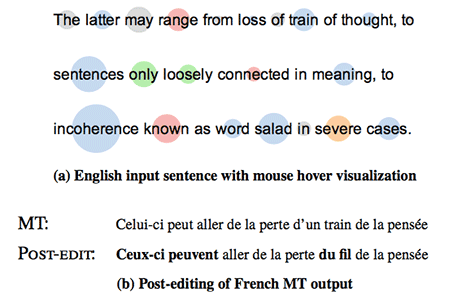UW Interactive Data Lab
papers

The Efficacy of Human Post-Editing for Language Translation
Spence Green, Jeffrey Heer, Christopher D. Manning.
Proc. ACM Human Factors in Computing Systems (CHI), 2013
Spence Green, Jeffrey Heer, Christopher D. Manning
Proc. ACM Human Factors in Computing Systems (CHI), 2013

Materials
PDF | Best Paper Award
Abstract
Language translation is slow and expensive, so various forms of machine assistance have been devised. Automatic machine translation systems process text quickly and cheaply, but with quality far below that of skilled human translators. To bridge this quality gap, the translation industry has investigated post-editing, or the manual correction of machine output. We present the first rigorous, controlled analysis of post-editing and find that post-editing leads to reduced time and, surprisingly, improved quality for three diverse language pairs (English to Arabic, French, and German). Our statistical models and visualizations of experimental data indicate that some simple predictors (like source text part of speech counts) predict translation time, and that post-editing results in very different interaction patterns. From these results we distill implications for the design of new language translation interfaces.
BibTeX
@inproceedings{2013-post-editing,
title = {The Efficacy of Human Post-Editing for Language Translation},
author = {Green, Spence AND Heer, Jeffrey AND Manning, Christopher},
booktitle = {Proc. ACM Human Factors in Computing Systems (CHI)},
year = {2013},
url = {https://idl.uw.edu/papers/post-editing},
doi = {10.1145/2470654.2470718}
}
